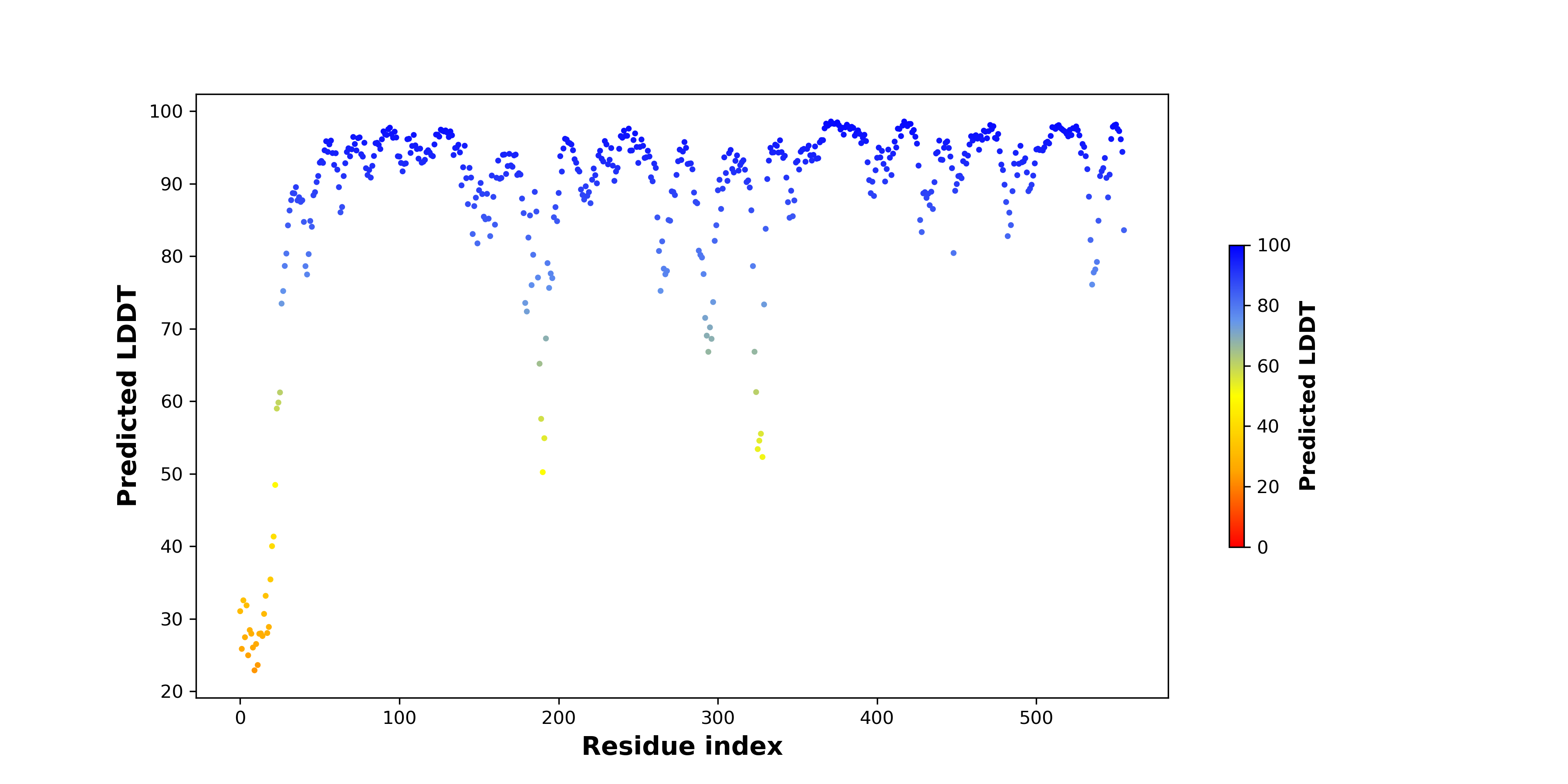| UTHEALTH HOME ABOUT SBMI A-Z WEBMAIL INSIDE THE UNIVERSITY |

|
|||||||
|
Fusion Protein:EIF3K-CYP39A1 |
Fusion Protein Summary |
 Fusion gene summary Fusion gene summary |
| Fusion partner gene information | Fusion gene name: EIF3K-CYP39A1 | FusionPDB ID: 25883 | FusionGDB2.0 ID: 25883 | Hgene | Tgene | Gene symbol | EIF3K | CYP39A1 | Gene ID | 27335 | 51302 |
| Gene name | eukaryotic translation initiation factor 3 subunit K | cytochrome P450 family 39 subfamily A member 1 | |
| Synonyms | ARG134|EIF3-p28|EIF3S12|HSPC029|M9|MSTP001|PLAC-24|PLAC24|PRO1474|PTD001 | - | |
| Cytomap | 19q13.2 | 6p12.3 | |
| Type of gene | protein-coding | protein-coding | |
| Description | eukaryotic translation initiation factor 3 subunit KeIF-3 p28eukaryotic translation initiation factor 3, subunit 12muscle specificmuscle-specific gene M9 protein | 24-hydroxycholesterol 7-alpha-hydroxylasecytochrome P450, family 39, subfamily A, polypeptide 1cytochrome P450, subfamily XXXIX (oxysterol 7 alpha-hydroxylase), polypeptide 1 | |
| Modification date | 20200322 | 20200313 | |
| UniProtAcc | Q9UBQ5 | Q9NYL5 | |
| Ensembl transtripts involved in fusion gene | ENST ids | ENST00000248342, ENST00000538434, ENST00000545173, ENST00000593149, ENST00000588934, ENST00000592558, ENST00000593062, | ENST00000489657, ENST00000275016, |
| Fusion gene scores for assessment (based on all fusion genes of FusionGDB 2.0) | * DoF score | 9 X 9 X 4=324 | 4 X 4 X 4=64 |
| # samples | 12 | 4 | |
| ** MAII score | log2(12/324*10)=-1.43295940727611 possibly effective Gene in Pan-Cancer Fusion Genes (peGinPCFGs). DoF>8 and MAII<0 | log2(4/64*10)=-0.678071905112638 possibly effective Gene in Pan-Cancer Fusion Genes (peGinPCFGs). DoF>8 and MAII<0 | |
| Context (manual curation of fusion genes in FusionPDB) | PubMed: EIF3K [Title/Abstract] AND CYP39A1 [Title/Abstract] AND fusion [Title/Abstract] | ||
| Most frequent breakpoint (based on all fusion genes of FusionGDB 2.0) | |||
| Anticipated loss of major functional domain due to fusion event. | |||
| * DoF score (Degree of Frequency) = # partners X # break points X # cancer types ** MAII score (Major Active Isofusion Index) = log2(# samples/DoF score*10) |
 Gene ontology of each fusion partner gene with evidence of Inferred from Direct Assay (IDA) from Entrez Gene ontology of each fusion partner gene with evidence of Inferred from Direct Assay (IDA) from Entrez |
| Partner | Gene | GO ID | GO term | PubMed ID |
| Hgene | EIF3K | GO:0006413 | translational initiation | 17581632 |
| Tgene | CYP39A1 | GO:0006699 | bile acid biosynthetic process | 10748047 |
 Fusion gene breakpoints across EIF3K (5'-gene) Fusion gene breakpoints across EIF3K (5'-gene)* Click on the image to open the UCSC genome browser with custom track showing this image in a new window. |
 Fusion gene breakpoints across CYP39A1 (3'-gene) Fusion gene breakpoints across CYP39A1 (3'-gene)* Click on the image to open the UCSC genome browser with custom track showing this image in a new window. |
Top |
Fusion Gene Sample Information |
 Fusion gene information from FusionGDB2.0. Fusion gene information from FusionGDB2.0. |
 Fusion gene information from two resources (ChiTars 5.0 and ChimerDB 4.0) Fusion gene information from two resources (ChiTars 5.0 and ChimerDB 4.0)* All genome coordinats were lifted-over on hg19. * Click on the break point to see the gene structure around the break point region using the UCSC Genome Browser. |
| Source | Disease | Sample | Hgene | Hchr | Hbp | Hstrand | Tgene | Tchr | Tbp | Tstrand |
| ChimerKB3 | . | . | EIF3K | chr19 | 39123318 | + | CYP39A1 | chr6 | 46607405 | - |
Top |
Fusion ORF Analysis |
 Fusion information from ORFfinder translation from full-length transcript sequence from FusionPDB. Fusion information from ORFfinder translation from full-length transcript sequence from FusionPDB. |
| Henst | Tenst | Hgene | Hchr | Hbp | Hstrand | Tgene | Tchr | Tbp | Tstrand | Seq length (transcript) | BP loci (transcript) | Predicted start (transcript) | Predicted stop (transcript) | Seq length (amino acids) |
| ENST00000593149 | EIF3K | chr19 | 39123318 | + | ENST00000275016 | CYP39A1 | chr6 | 46607405 | - | 2228 | 569 | 145 | 1665 | 506 |
| ENST00000248342 | EIF3K | chr19 | 39123318 | + | ENST00000275016 | CYP39A1 | chr6 | 46607405 | - | 2330 | 671 | 52 | 1767 | 571 |
| ENST00000538434 | EIF3K | chr19 | 39123318 | + | ENST00000275016 | CYP39A1 | chr6 | 46607405 | - | 2132 | 473 | 181 | 1569 | 462 |
| ENST00000545173 | EIF3K | chr19 | 39123318 | + | ENST00000275016 | CYP39A1 | chr6 | 46607405 | - | 2234 | 575 | 1 | 1671 | 556 |
 DeepORF prediction of the coding potential based on the fusion transcript sequence of in-frame fusion genes. DeepORF is a coding potential classifier based on convolutional neural network by comparing the real Ribo-seq data. If the no-coding score < 0.5 and coding score > 0.5, then the in-frame fusion transcript is predicted as being likely translated. DeepORF prediction of the coding potential based on the fusion transcript sequence of in-frame fusion genes. DeepORF is a coding potential classifier based on convolutional neural network by comparing the real Ribo-seq data. If the no-coding score < 0.5 and coding score > 0.5, then the in-frame fusion transcript is predicted as being likely translated. |
| Henst | Tenst | Hgene | Hchr | Hbp | Hstrand | Tgene | Tchr | Tbp | Tstrand | No-coding score | Coding score |
Top |
Fusion Amino Acid Sequences |
 For individual full-length fusion transcript sequence from FusionPDB, we ran ORFfinder and chose the longest ORF among the all predicted ones. For individual full-length fusion transcript sequence from FusionPDB, we ran ORFfinder and chose the longest ORF among the all predicted ones. |
| >FusionGDB ID_FusionGDB isoform ID_FGname_Hgene_Hchr_Hbp_Henst_Tgene_Tchr_Tbp_Tenst_length(fusion AA) seq_BP >25883_25883_1_EIF3K-CYP39A1_EIF3K_chr19_39123318_ENST00000248342_CYP39A1_chr6_46607405_ENST00000275016_length(amino acids)=571AA_BP=206 MERQQRRRFRFHHLFLFPSLRTPCRVSVSLQPWLWKATEVMAMFEQMRANVGKLLKGIDRYNPENLATLERYVETQAKENAYDLEANLAV LKLYQFNPAFFQTTVTAQILLKALTNLPHTDFTLCKCMIDQAHQEERPIRQILYLGDLLETCHFQAFWQALDENMDLLEGITGFEDSVRK FICHVVGITYQHIDRWLLAEMLGDLSASIPKNVFLALHEKLYIMLKGKMGTVNLHQFTGQLTEELHEQLENLGTHGTMDLNNLVRHLLYP VTVNMLFNKSLFSTNKKKIKEFHQYFQVYDEDFEYGSQLPECLLRNWSKSKKWFLELFEKNIPDIKACKSAKDNSMTLLQATLDIVETET SKENSPNYGLLLLWASLSNAVPVAFWTLAYVLSHPDIHKAIMEGISSVFGKAGKDKIKVSEDDLENLLLIKWCVLETIRLKAPGVITRKV VKPVEILNYIIPSGDLLMLSPFWLHRNPKYFPEPELFKPERWKKANLEKHSFLDCFMAFGSGKFQCPARWFALLEVQMCIILILYKYDCS -------------------------------------------------------------- >25883_25883_2_EIF3K-CYP39A1_EIF3K_chr19_39123318_ENST00000538434_CYP39A1_chr6_46607405_ENST00000275016_length(amino acids)=462AA_BP=97 MLKALTNLPHTDFTLCKCMIDQAHQEERPIRQILYLGDLLETCHFQAFWQALDENMDLLEGITGFEDSVRKFICHVVGITYQHIDRWLLA EMLGDLSASIPKNVFLALHEKLYIMLKGKMGTVNLHQFTGQLTEELHEQLENLGTHGTMDLNNLVRHLLYPVTVNMLFNKSLFSTNKKKI KEFHQYFQVYDEDFEYGSQLPECLLRNWSKSKKWFLELFEKNIPDIKACKSAKDNSMTLLQATLDIVETETSKENSPNYGLLLLWASLSN AVPVAFWTLAYVLSHPDIHKAIMEGISSVFGKAGKDKIKVSEDDLENLLLIKWCVLETIRLKAPGVITRKVVKPVEILNYIIPSGDLLML SPFWLHRNPKYFPEPELFKPERWKKANLEKHSFLDCFMAFGSGKFQCPARWFALLEVQMCIILILYKYDCSLLDPLPKQSYLHLVGVPQP -------------------------------------------------------------- >25883_25883_3_EIF3K-CYP39A1_EIF3K_chr19_39123318_ENST00000545173_CYP39A1_chr6_46607405_ENST00000275016_length(amino acids)=556AA_BP=191 LFPSLRTPCRVSVSLQPWLWKATEVMAMFEQMRANVGKLLKGIDRYNPENLATLERYVETQAKENAYDLEANLAVLKLYQFNPAFFQTTV TAQILLKALTNLPHTDFTLCKCMIDQAHQEERPIRQILYLGDLLETCHFQAFWQALDENMDLLEGITGFEDSVRKFICHVVGITYQHIDR WLLAEMLGDLSASIPKNVFLALHEKLYIMLKGKMGTVNLHQFTGQLTEELHEQLENLGTHGTMDLNNLVRHLLYPVTVNMLFNKSLFSTN KKKIKEFHQYFQVYDEDFEYGSQLPECLLRNWSKSKKWFLELFEKNIPDIKACKSAKDNSMTLLQATLDIVETETSKENSPNYGLLLLWA SLSNAVPVAFWTLAYVLSHPDIHKAIMEGISSVFGKAGKDKIKVSEDDLENLLLIKWCVLETIRLKAPGVITRKVVKPVEILNYIIPSGD LLMLSPFWLHRNPKYFPEPELFKPERWKKANLEKHSFLDCFMAFGSGKFQCPARWFALLEVQMCIILILYKYDCSLLDPLPKQSYLHLVG -------------------------------------------------------------- >25883_25883_4_EIF3K-CYP39A1_EIF3K_chr19_39123318_ENST00000593149_CYP39A1_chr6_46607405_ENST00000275016_length(amino acids)=506AA_BP=141 MATLERYVETQAKENAYDLEANLAVLKLYQFNPAFFQTTVTAQILLKALTNLPHTDFTLCKCMIDQAHQEERPIRQILYLGDLLETCHFQ AFWQALDENMDLLEGITGFEDSVRKFICHVVGITYQHIDRWLLAEMLGDLSASIPKNVFLALHEKLYIMLKGKMGTVNLHQFTGQLTEEL HEQLENLGTHGTMDLNNLVRHLLYPVTVNMLFNKSLFSTNKKKIKEFHQYFQVYDEDFEYGSQLPECLLRNWSKSKKWFLELFEKNIPDI KACKSAKDNSMTLLQATLDIVETETSKENSPNYGLLLLWASLSNAVPVAFWTLAYVLSHPDIHKAIMEGISSVFGKAGKDKIKVSEDDLE NLLLIKWCVLETIRLKAPGVITRKVVKPVEILNYIIPSGDLLMLSPFWLHRNPKYFPEPELFKPERWKKANLEKHSFLDCFMAFGSGKFQ -------------------------------------------------------------- |
Top |
Fusion Protein Functional Features |
 Four levels of functional features of fusion genes Four levels of functional features of fusion genesGo to FGviewer search page for the most frequent breakpoint (https://ccsmweb.uth.edu/FGviewer/chr19:/chr6:) - FGviewer provides the online visualization of the retention search of the protein functional features across DNA, RNA, protein, and pathological levels. - How to search 1. Put your fusion gene symbol. 2. Press the tab key until there will be shown the breakpoint information filled. 4. Go down and press 'Search' tab twice. 4. Go down to have the hyperlink of the search result. 5. Click the hyperlink. 6. See the FGviewer result for your fusion gene. |
 |
 Main function of each fusion partner protein. (from UniProt) Main function of each fusion partner protein. (from UniProt) |
| Hgene | Tgene |
| EIF3K | CYP39A1 |
| FUNCTION: Component of the eukaryotic translation initiation factor 3 (eIF-3) complex, which is required for several steps in the initiation of protein synthesis (PubMed:17581632, PubMed:25849773, PubMed:27462815). The eIF-3 complex associates with the 40S ribosome and facilitates the recruitment of eIF-1, eIF-1A, eIF-2:GTP:methionyl-tRNAi and eIF-5 to form the 43S pre-initiation complex (43S PIC). The eIF-3 complex stimulates mRNA recruitment to the 43S PIC and scanning of the mRNA for AUG recognition. The eIF-3 complex is also required for disassembly and recycling of post-termination ribosomal complexes and subsequently prevents premature joining of the 40S and 60S ribosomal subunits prior to initiation (PubMed:17581632). The eIF-3 complex specifically targets and initiates translation of a subset of mRNAs involved in cell proliferation, including cell cycling, differentiation and apoptosis, and uses different modes of RNA stem-loop binding to exert either translational activation or repression (PubMed:25849773). {ECO:0000255|HAMAP-Rule:MF_03010, ECO:0000269|PubMed:17581632, ECO:0000269|PubMed:25849773, ECO:0000269|PubMed:27462815}. | FUNCTION: A cytochrome P450 monooxygenase involved in neural cholesterol clearance through bile acid synthesis (PubMed:25201972, PubMed:10748047). Catalyzes 7-alpha hydroxylation of (24S)-hydroxycholesterol, a neural oxysterol that is metabolized to bile acids in the liver (PubMed:25201972, PubMed:10748047). Mechanistically, uses molecular oxygen inserting one oxygen atom into a substrate, and reducing the second into a water molecule, with two electrons provided by NADPH via cytochrome P450 reductase (CPR; NADPH-ferrihemoprotein reductase) (PubMed:25201972, PubMed:10748047). {ECO:0000269|PubMed:10748047, ECO:0000269|PubMed:25201972}. |
 Retention analysis result of each fusion partner protein across 39 protein features of UniProt such as six molecule processing features, 13 region features, four site features, six amino acid modification features, two natural variation features, five experimental info features, and 3 secondary structure features. Here, because of limited space for viewing, we only show the protein feature retention information belong to the 13 regional features. All retention annotation result can be downloaded at * Minus value of BPloci means that the break pointn is located before the CDS. Retention analysis result of each fusion partner protein across 39 protein features of UniProt such as six molecule processing features, 13 region features, four site features, six amino acid modification features, two natural variation features, five experimental info features, and 3 secondary structure features. Here, because of limited space for viewing, we only show the protein feature retention information belong to the 13 regional features. All retention annotation result can be downloaded at * Minus value of BPloci means that the break pointn is located before the CDS. |
| - Retained protein feature among the 13 regional features. |
| Partner | Gene | Hbp | Tbp | ENST | Strand | BPexon | TotalExon | Protein feature loci | *BPloci | TotalLen | Protein feature | Protein feature note |
| - Not-retained protein feature among the 13 regional features. |
| Partner | Gene | Hbp | Tbp | ENST | Strand | BPexon | TotalExon | Protein feature loci | *BPloci | TotalLen | Protein feature | Protein feature note |
Top |
Fusion Protein Structures |
 PDB and CIF files of the predicted fusion proteins PDB and CIF files of the predicted fusion proteins * Here we show the 3D structure of the fusion proteins using Mol*. AlphaFold produces a per-residue confidence score (pLDDT) between 0 and 100. Model confidence is shown from the pLDDT values per residue. pLDDT corresponds to the model’s prediction of its score on the local Distance Difference Test. It is a measure of local accuracy (from AlphfaFold website). To color code individual residues, we transformed individual PDB files into CIF format. |
| Fusion protein PDB link (fusion AA seq ID in FusionPDB) | Hgene | Hchr | Hbp | Hstrand | Tgene | Tchr | Tbp | Tstrand | AA seq | Len(AA seq) |
| PDB file (235) >>>235.pdbFusion protein BP residue: 97 CIF file (235) >>>235.cif | EIF3K | chr19 | 39123318 | + | CYP39A1 | chr6 | 46607405 | - | MLKALTNLPHTDFTLCKCMIDQAHQEERPIRQILYLGDLLETCHFQAFWQ ALDENMDLLEGITGFEDSVRKFICHVVGITYQHIDRWLLAEMLGDLSASI PKNVFLALHEKLYIMLKGKMGTVNLHQFTGQLTEELHEQLENLGTHGTMD LNNLVRHLLYPVTVNMLFNKSLFSTNKKKIKEFHQYFQVYDEDFEYGSQL PECLLRNWSKSKKWFLELFEKNIPDIKACKSAKDNSMTLLQATLDIVETE TSKENSPNYGLLLLWASLSNAVPVAFWTLAYVLSHPDIHKAIMEGISSVF GKAGKDKIKVSEDDLENLLLIKWCVLETIRLKAPGVITRKVVKPVEILNY IIPSGDLLMLSPFWLHRNPKYFPEPELFKPERWKKANLEKHSFLDCFMAF GSGKFQCPARWFALLEVQMCIILILYKYDCSLLDPLPKQSYLHLVGVPQP | 462 |
| 3D view using mol* of 235 (AA BP:97) | ||||||||||
 | ||||||||||
| PDB file (317) >>>317.pdbFusion protein BP residue: 141 CIF file (317) >>>317.cif | EIF3K | chr19 | 39123318 | + | CYP39A1 | chr6 | 46607405 | - | MATLERYVETQAKENAYDLEANLAVLKLYQFNPAFFQTTVTAQILLKALT NLPHTDFTLCKCMIDQAHQEERPIRQILYLGDLLETCHFQAFWQALDENM DLLEGITGFEDSVRKFICHVVGITYQHIDRWLLAEMLGDLSASIPKNVFL ALHEKLYIMLKGKMGTVNLHQFTGQLTEELHEQLENLGTHGTMDLNNLVR HLLYPVTVNMLFNKSLFSTNKKKIKEFHQYFQVYDEDFEYGSQLPECLLR NWSKSKKWFLELFEKNIPDIKACKSAKDNSMTLLQATLDIVETETSKENS PNYGLLLLWASLSNAVPVAFWTLAYVLSHPDIHKAIMEGISSVFGKAGKD KIKVSEDDLENLLLIKWCVLETIRLKAPGVITRKVVKPVEILNYIIPSGD LLMLSPFWLHRNPKYFPEPELFKPERWKKANLEKHSFLDCFMAFGSGKFQ CPARWFALLEVQMCIILILYKYDCSLLDPLPKQSYLHLVGVPQPEGQCRI | 506 |
| 3D view using mol* of 317 (AA BP:141) | ||||||||||
 | ||||||||||
| PDB file (401) >>>401.pdbFusion protein BP residue: 191 CIF file (401) >>>401.cif | EIF3K | chr19 | 39123318 | + | CYP39A1 | chr6 | 46607405 | - | LFPSLRTPCRVSVSLQPWLWKATEVMAMFEQMRANVGKLLKGIDRYNPEN LATLERYVETQAKENAYDLEANLAVLKLYQFNPAFFQTTVTAQILLKALT NLPHTDFTLCKCMIDQAHQEERPIRQILYLGDLLETCHFQAFWQALDENM DLLEGITGFEDSVRKFICHVVGITYQHIDRWLLAEMLGDLSASIPKNVFL ALHEKLYIMLKGKMGTVNLHQFTGQLTEELHEQLENLGTHGTMDLNNLVR HLLYPVTVNMLFNKSLFSTNKKKIKEFHQYFQVYDEDFEYGSQLPECLLR NWSKSKKWFLELFEKNIPDIKACKSAKDNSMTLLQATLDIVETETSKENS PNYGLLLLWASLSNAVPVAFWTLAYVLSHPDIHKAIMEGISSVFGKAGKD KIKVSEDDLENLLLIKWCVLETIRLKAPGVITRKVVKPVEILNYIIPSGD LLMLSPFWLHRNPKYFPEPELFKPERWKKANLEKHSFLDCFMAFGSGKFQ CPARWFALLEVQMCIILILYKYDCSLLDPLPKQSYLHLVGVPQPEGQCRI | 556 |
| 3D view using mol* of 401 (AA BP:191) | ||||||||||
 | ||||||||||
| PDB file (426) >>>426.pdbFusion protein BP residue: 206 CIF file (426) >>>426.cif | EIF3K | chr19 | 39123318 | + | CYP39A1 | chr6 | 46607405 | - | MERQQRRRFRFHHLFLFPSLRTPCRVSVSLQPWLWKATEVMAMFEQMRAN VGKLLKGIDRYNPENLATLERYVETQAKENAYDLEANLAVLKLYQFNPAF FQTTVTAQILLKALTNLPHTDFTLCKCMIDQAHQEERPIRQILYLGDLLE TCHFQAFWQALDENMDLLEGITGFEDSVRKFICHVVGITYQHIDRWLLAE MLGDLSASIPKNVFLALHEKLYIMLKGKMGTVNLHQFTGQLTEELHEQLE NLGTHGTMDLNNLVRHLLYPVTVNMLFNKSLFSTNKKKIKEFHQYFQVYD EDFEYGSQLPECLLRNWSKSKKWFLELFEKNIPDIKACKSAKDNSMTLLQ ATLDIVETETSKENSPNYGLLLLWASLSNAVPVAFWTLAYVLSHPDIHKA IMEGISSVFGKAGKDKIKVSEDDLENLLLIKWCVLETIRLKAPGVITRKV VKPVEILNYIIPSGDLLMLSPFWLHRNPKYFPEPELFKPERWKKANLEKH SFLDCFMAFGSGKFQCPARWFALLEVQMCIILILYKYDCSLLDPLPKQSY | 571 |
| 3D view using mol* of 426 (AA BP:206) | ||||||||||
 | ||||||||||
Top |
pLDDT score distribution |
 pLDDT score distribution of the predicted wild-type structures of two partner proteins from AlphaFold2 pLDDT score distribution of the predicted wild-type structures of two partner proteins from AlphaFold2* AlphaFold produces a per-residue confidence score (pLDDT) between 0 and 100. |
EIF3K_pLDDT.png |
CYP39A1_pLDDT.png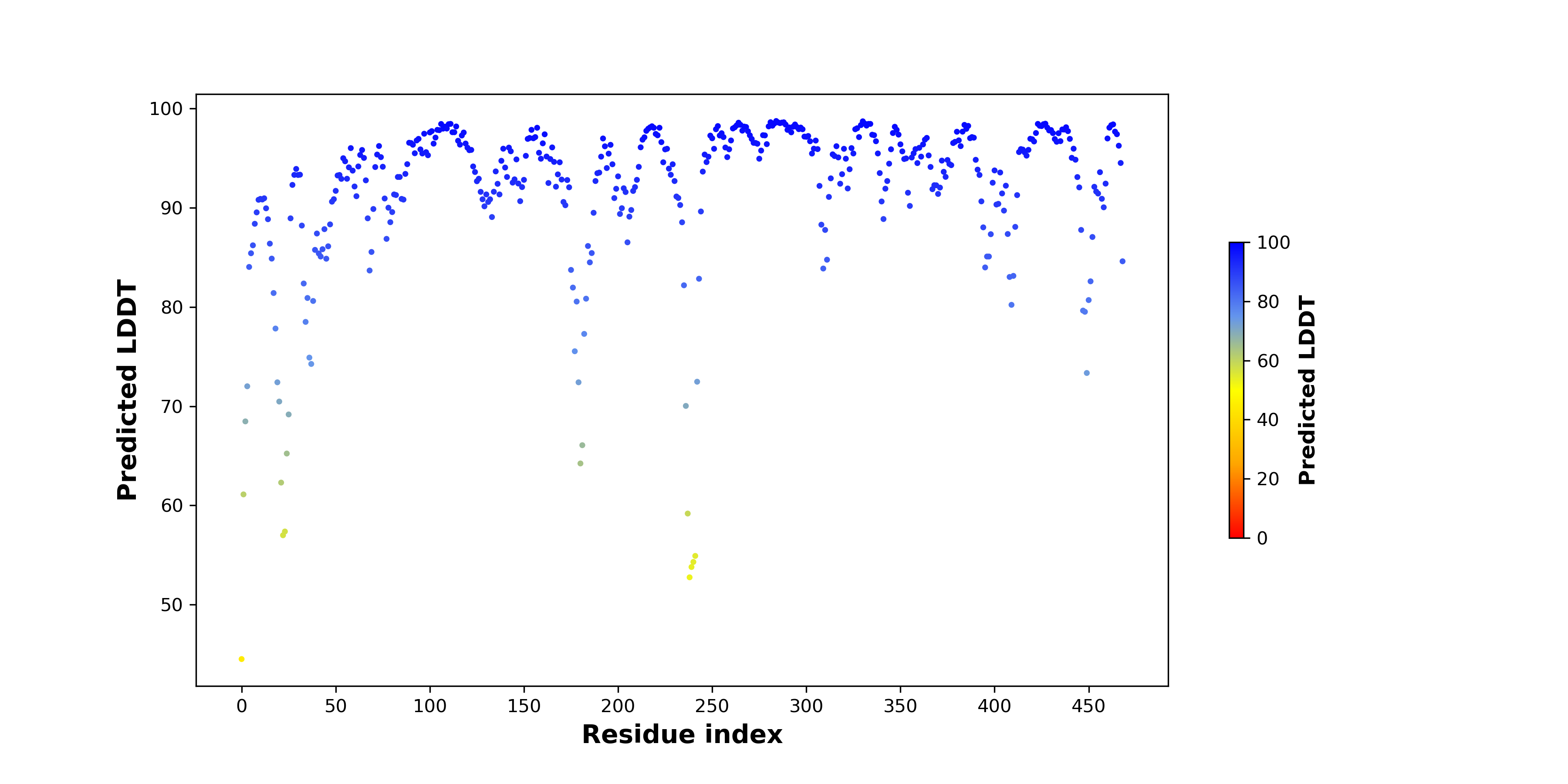 |
 pLDDT score distribution of the predicted fusion protein structures from AlphaFold2 pLDDT score distribution of the predicted fusion protein structures from AlphaFold2* AlphaFold produces a per-residue confidence score (pLDDT) between 0 and 100. |
Top |
Ramachandran Plot of Fusion Protein Structure |
 Ramachandran plot of the torsional angles - phi (φ)and psi (ψ) - of the residues (amino acids) contained in this fusion protein peptide. Ramachandran plot of the torsional angles - phi (φ)and psi (ψ) - of the residues (amino acids) contained in this fusion protein peptide. |
| Fusion AA seq ID in FusionPDB and their Ramachandran plots |
| EIF3K_CYP39A1_235.png |
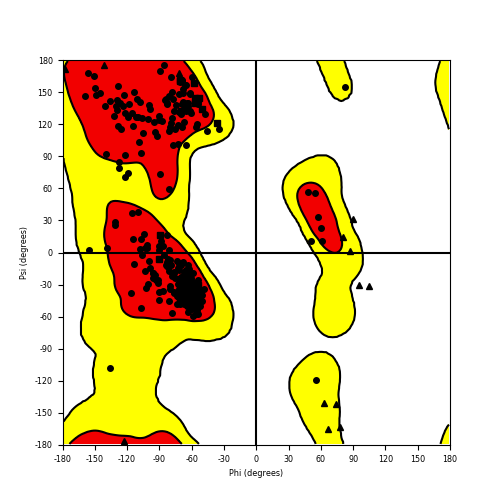 |
| EIF3K_CYP39A1_317.png |
 |
| EIF3K_CYP39A1_401.png |
 |
| EIF3K_CYP39A1_426.png |
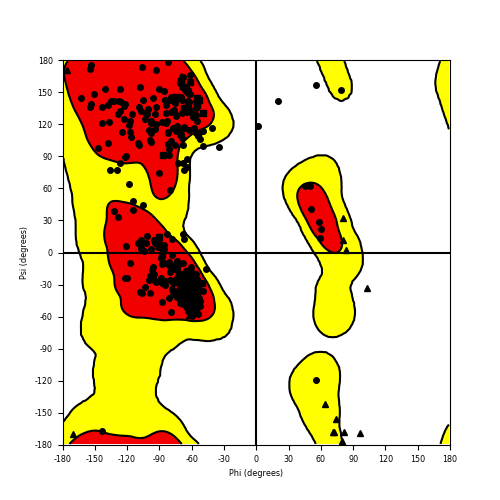 |
Top |
Potential Active Site Information |
 The potential binding sites of these fusion proteins were identified using SiteMap, a module of the Schrodinger suite. The potential binding sites of these fusion proteins were identified using SiteMap, a module of the Schrodinger suite. |
| Fusion AA seq ID in FusionPDB | Site score | Size | D score | Volume | Exposure | Enclosure | Contact | Phobic | Philic | Balance | Don/Acc | Residues |
| 235 | 1.195 | 223 | 1.28 | 636.608 | 0.479 | 0.829 | 0.941 | 2.26 | 0.481 | 4.696 | 1.314 | Chain A: 105,109,112,113,116,120,163,167,168,239,2 40,243,259,262,263,266,267,270,271,274,325,329,334 ,336,337,338,339,362,399,400,401,405,406,407,408,4 09,410,412,413,414,416,417,445,446,447 |
| 317 | 1.075 | 410 | 1.119 | 1294.139 | 0.583 | 0.749 | 0.92 | 1.158 | 0.83 | 1.396 | 1.121 | Chain A: 90,93,94,96,97,100,110,114,129,130,131,13 4,135,138,139,140,141,142,143,144,145,146,147,149, 153,156,157,160,164,203,207,211,234,238,239,240,24 2,243,244,283,287,303,305,306,307,309,310,311,312, 314,315,316,318,373,378,380,381,382,383,404,406,43 5,436,437,438,439,440,441,442,443,444,445,446,449, 450,451,452,453,454,455,456,457,458,460,461,488,48 9,490,491 |
| 401 | 1.1255 | 347 | 1.2005 | 1024.884 | 0.5684 | 0.7573 | 0.8996 | 1.6497 | 0.5946 | 2.7747 | 0.8256 | Chain A: 181,191,192,193,194,199,203,206,207,209,2 10,214,257,261,284,286,287,288,289,290,291,292,293 ,302,306,333,337,352,353,355,356,357,359,360,361,3 64,365,368,419,423,427,428,429,430,431,432,433,452 ,454,455,457,458,493,494,495,496,498,499,500,501,5 02,503,506,507,508,510,511,533,534,535,536,537,538 ,539,540,541,542 |
| 426 | 0.93 | 5662 | 1.04 | 2939.853 | 0.688 | 0.438 | 0.394 | 0.261 | 0.5 | 0.522 | 0.961 | Chain A: 1,2,3,4,5,6,7,8,9,10,11,12,13,14,15,16,17 ,28,29,30,31,33,34,36,37,40,41,48,49,51,52,55,56,5 7,79,80,81,82,83,84,85,112,113,114,115,116,117,118 ,119,120,121,122,123,146,150,152,153,154,155,156,1 58,159,161,162,163,165,168,169,170,171,172,173,174 ,175,176,177,179,180,181,183,184,185,186,187,188,1 89,190,191,192,193,194,195,196,197,198,199,200,201 ,203,204,205,206,207,208,209,210,211,212,214,215,2 16,218,219,220,221,222,225,229,244,247,248,251,252 ,258,259,261,262,265,266,267,269,270,273,274,276,2 79,280,281,282,283,284,285,286,287,288,289,290,291 ,293,294,295,297,298,299,300,301,302,303,304,305,3 06,307,308,309,310,311,312,313,314,315,316,317,318 ,319,320,321,322,323,325,326,327,329,330,331,332,3 33,334,336,348,352,357,362,363,364,365,366,367,368 ,370,371,372,374,375,376,378,379,380,382,383,386,3 90,392,393,394,395,396,397,398,400,401,404,407,408 ,426,427,428,429,430,432,434,438,440,441,443,444,4 45,446,447,448,449,450,451,452,454,456,459,461,463 ,464,466,467,468,469,470,471,472,473,474,476,477,4 78,485,486,487,488,489,490,493,507,508,509,510,511 ,512,513,514,515,516,517,518,521,522,523,525,526,5 38,539,540,541,543,544,545,546,547,548,549,550,551 ,552,553,554,555,556,557,558,559,560,561,562,566,5 67,568 |
Top |
Potentially Interacting Small Molecules through Virtual Screening |
 The FDA-approved small molecule library molecules were subjected to virtual screening using the Glide. The FDA-approved small molecule library molecules were subjected to virtual screening using the Glide. |
| Fusion AA seq ID in FusionPDB | ZINC ID | DrugBank ID | Drug name | Docking score | Glide gscore |
Top |
 Drug information from DrugBank of the top 20 interacting small molecules. Drug information from DrugBank of the top 20 interacting small molecules. |
| ZINC ID | DrugBank ID | Drug name | Drug type | SMILES | Drug group |
Top |
Biochemical Features of Small Molecules |
 ADME (Absorption, Distribution, Metabolism, and Excretion) of drugs using QikProp(v3.9) ADME (Absorption, Distribution, Metabolism, and Excretion) of drugs using QikProp(v3.9) |
| ZINC ID | mol_MW | dipole | SASA | FOSA | FISA | PISA | WPSA | volume | donorHB | accptHB | IP | Human Oral Absorption | Percent Human Oral Absorption | Rule Of Five | Rule Of Three |
Top |
Drug Toxicity Information |
 Toxicity information of individual drugs using eToxPred Toxicity information of individual drugs using eToxPred |
| ZINC ID | Smile | Surface Accessibility | Toxicity |
Top |
Fusion Protein-Protein Interaction |
 Go to ChiPPI (Chimeric Protein-Protein interactions) to see the chimeric PPI interaction in Go to ChiPPI (Chimeric Protein-Protein interactions) to see the chimeric PPI interaction in |
 Protein-protein interactors with each fusion partner protein in wild-type from validated records (BIOGRID-3.4.160) Protein-protein interactors with each fusion partner protein in wild-type from validated records (BIOGRID-3.4.160) |
| Gene | PPI interactors |
| EIF3K | CCND3, EIF3L, EIF4A2, EIF3A, EIF1B, EIF3J, EIF3G, EIF3C, EIF3H, EIF3F, Eif3a, EIF3B, SPP1, EIF3E, EIF3D, EIF3I, EIF3M, DDX3X, FN1, METTL18, ITGA4, gag-pol, MMS19, CD81, IGSF8, ICAM1, DDX1, DIMT1, DYNC1H1, DYNC1I2, DYNC1LI2, EIF2A, EIF2B2, HNRNPD, PA2G4, PRUNE2, RPS10, RPS26, GNB2L1, LARP1, MAP2, WNK1, YBX1, EGFR, EIF3CL, EIF2B5, UTP15, IFI16, HERC2, VAPA, Eif3e, Eif3i, Rpl35, PTPRN, DNALI1, PFN2, GSN, ARPC4, CYLD, DLD, G3BP1, CFTR, CLEC14A, ZNF598, UBE2M, PRPF8, EFTUD2, PML, ESR2, HEXIM1, EZH2, RECQL4, VCP, KIAA1429, EIF4B, TANK, TNIP2, NR2C2, APEX1, CD74, DDX60, P2RY6, TNFSF13B, NFX1, WWP2, PLEKHA4, RAB5A, nsp1, ESR1, CHMP4C, FASN, nsp2ab, COPS5, EIF4E, EIF4G3, EIF4EBP2, EIF4ENIF1, EIF4EBP1, ANGEL1, EIF4G1, UFL1, SEC61B, FZR1, NUDCD2, CCNF, |
 Protein-protein interactors based on sequence similarity (STRING) Protein-protein interactors based on sequence similarity (STRING) |
| Gene | STRING network |
| EIF3K |  |
| CYP39A1 | 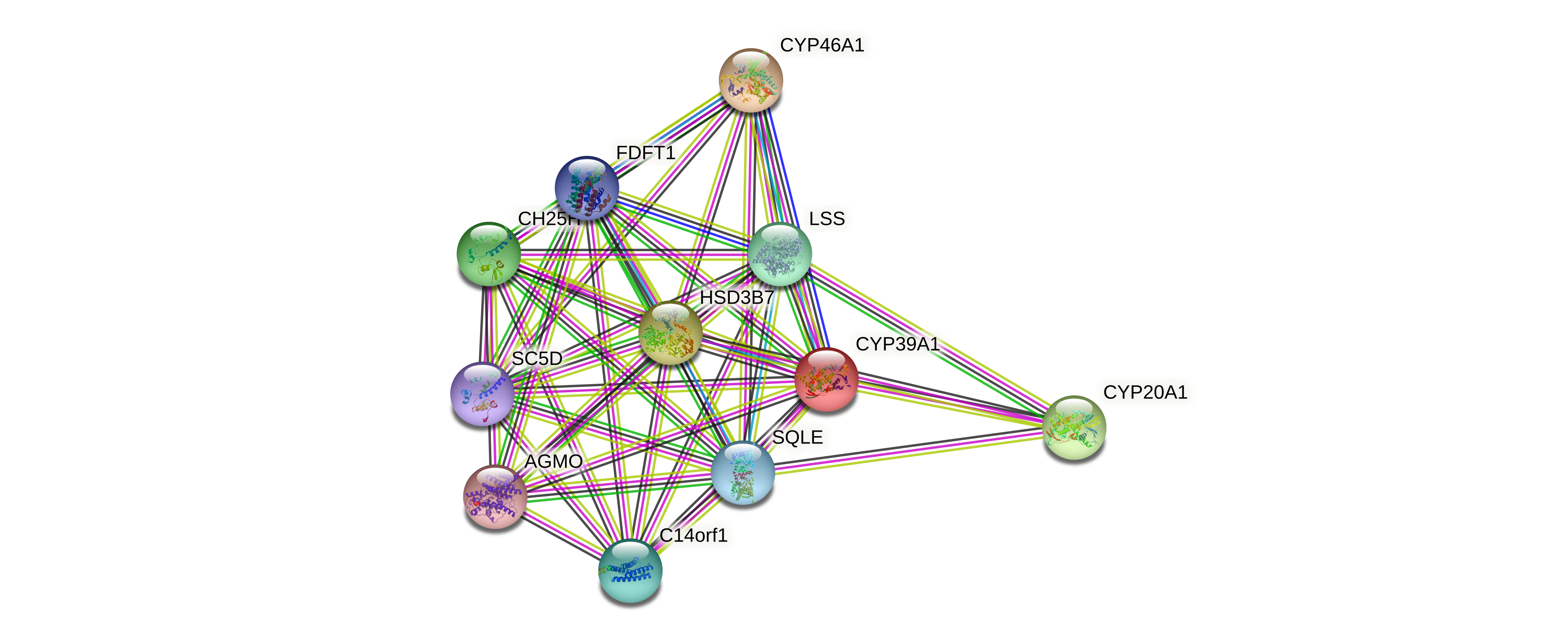 |
 - Retained interactions in fusion protein (protein functional feature from UniProt). - Retained interactions in fusion protein (protein functional feature from UniProt). |
| Partner | Gene | Hbp | Tbp | ENST | Strand | BPexon | TotalExon | Protein feature loci | *BPloci | TotalLen | Still interaction with |
 - Lost interactions due to fusion (protein functional feature from UniProt). - Lost interactions due to fusion (protein functional feature from UniProt). |
| Partner | Gene | Hbp | Tbp | ENST | Strand | BPexon | TotalExon | Protein feature loci | *BPloci | TotalLen | Interaction lost with |
Top |
Related Drugs to EIF3K-CYP39A1 |
 Drugs used for this fusion-positive patient. Drugs used for this fusion-positive patient. (Manual curation of PubMed, 04-30-2022 + MyCancerGenome) |
| Hgene | Tgene | Drug | Source | PMID |
Top |
Related Diseases to EIF3K-CYP39A1 |
 Diseases that have this fusion gene. Diseases that have this fusion gene. (Manual curation of PubMed, 04-30-2022 + MyCancerGenome) |
| Hgene | Tgene | Disease | Source | PMID |
 Diseases associated with fusion partners. Diseases associated with fusion partners. (DisGeNet 4.0) |
| Partner | Gene | Disease ID | Disease name | # pubmeds | Source |
| Tgene | CYP39A1 | C2239176 | Liver carcinoma | 1 | CTD_human |








